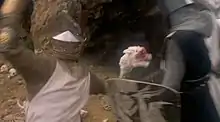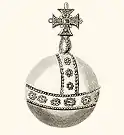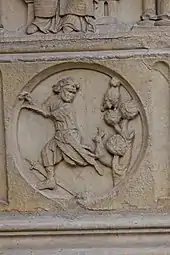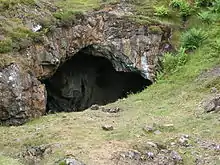Rabbit of Caerbannog
The Killer Rabbit of Caerbannog is a fictional character in the Monty Python film Monty Python and the Holy Grail.[1] The scene in Holy Grail was written by Graham Chapman and John Cleese.[2] The rabbit is the antagonist in a major set piece battle, and makes a similar appearance in Spamalot, a musical inspired by the movie.[3] The iconic status of this scene was important in establishing the viability of the musical.[4]
| Rabbit of Caerbannog | |
|---|---|
| Monty Python character | |
 The Killer Rabbit attacks Lancelot | |
| First appearance | Monty Python and the Holy Grail |
| Last appearance | Spamalot |
| Created by | Monty Python and Eric Idle |
| In-universe information | |
| Species | Rabbit |
In the film
The Cave of Caerbannog is the home of the Legendary Black Beast of Arrrghhh.[5] This is guarded by a monster whose nature is initially unknown.[6] King Arthur (Graham Chapman) and his knights are led to the cave by Tim the Enchanter (John Cleese) and find that they must face its guardian beast. Tim verbally paints a picture of a monster so terrible that it has killed everyone who has tried to enter the cave, and warns them, "...for death awaits you all with nasty, big, pointy teeth!" As the knights approach the cave, their "horses" become nervous, forcing the knights to dismount. Despite the entrance being surrounded by the bones of "full fifty men", Arthur and his knights no longer take Tim seriously when they see a rabbit emerge from the cave. After mocking Tim for frightening them ("You manky Scots git!") and ignoring his further warnings ("Look, that rabbit's got a vicious streak a mile wide!"), King Arthur orders Sir Bors (Terry Gilliam) to chop the rabbit's head off. Bors draws his sword and confidently approaches it. The rabbit suddenly leaps from several feet away directly at Bors' neck and bites clean through it in a single motion, decapitating him to the sound of a can opener. Despite their initial shock, the knights attack, but the rabbit also kills Gawain and Ector and wounds several of the other knights. Arthur panics and shouts for the knights to retreat ("Run away! Run away!"), to the sound of Tim's raucous laughter. As the remaining knights regroup, Sir Robin asks if "running away more" would confuse it, and Sir Galahad suggests taunting the rabbit to cause it to make a mistake. Sir Lancelot (John Cleese) asks, "Have we got bows?" ("No", says Arthur), but then Lancelot recalls, "We have the Holy Hand Grenade!"[7]
Holy Hand Grenade of Antioch

The Holy Hand Grenade of Antioch is a visual satire of the Sovereign's Orb of the United Kingdom, having the form of a globus cruciger, and may refer to the mythical Holy Spear of Antioch. The Holy Hand Grenade is described as one of the "sacred relics" carried by Brother Maynard (Eric Idle). Despite its ornate appearance and long-winded instructions, it functions much the same as any other hand grenade, with the cross functioning as the safety pin. At King Arthur's prompting, instructions for its use are read aloud by a cleric (Michael Palin) from the fictitious Book of Armaments, Chapter 2, verses 9–21, parodying the King James Bible and the Athanasian Creed:
...And Saint Attila raised the hand grenade up on high, saying, "O LORD, bless this Thy hand grenade, that with it Thou mayest blow Thine enemies to tiny bits, in Thy mercy." And the LORD did grin, and the people did feast upon the lambs and sloths and carp and anchovies and orangutans and breakfast cereals, and fruit bats and large chu... [At this point, the friar is urged by Brother Maynard to "skip a bit, brother"]... And the LORD spake, saying, "First shalt thou take out the Holy Pin. Then shalt thou count to three, no more, no less. Three shall be the number thou shalt count, and the number of the counting shall be three. Four shalt thou not count, neither count thou two, excepting that thou then proceed to three. Five is right out! Once the number three, being the third number, be reached, then lobbest thou thy Holy Hand Grenade of Antioch towards thy foe, who, being naughty in My sight, shall snuff it."[8]
Arthur then pulls the pin, holds up the Holy Hand Grenade and counts "One! Two! Five!" Sir Galahad (also Palin) corrects him: "Three, sir!" (Arthur's innumeracy is a running gag in the picture).[8] Arthur then yells "Three!" and hurls the grenade towards the rabbit. The grenade soars through the air—accompanied by a short bit of angelic choral a cappella—bounces, and blows up the killer rabbit. The hapless knights errant continue on their quest, but the sound of the explosion also attracts the attention of policemen who are investigating the murder of a historian by a mounted knight earlier in the film.
Production
The rabbit scene was shot outside the Tomnadashan mine,[9] a cave four miles (6.4 km) from the Perthshire village of Killin. For the 25th-anniversary DVD, Michael Palin and Terry Jones returned to be interviewed in front of the cave but they could not remember the location.[10][11]
The rabbit was portrayed in the movie by both a real rabbit and a puppet.[12]
The name "Caerbannog", though fictitious, does reference real-world Welsh naming traditions: the element caer means 'castle', as in Caerdydd (Cardiff) and Caerphilly, and bannog can have a variety of meanings, the most apposite here being "turreted".
Antecedents

Killer rabbits are a medieval literary tradition, going back at least to the 1170s, with illuminations in which the rabbits seek justice against the hunters.[13] It appears in the early story of the Roman de Renart in which a foe takes hubristic pride in his defeat of a ferocious hare:[14]
Si li crachait en mi le vis
Et escopi par grant vertu[15]
The idea for the rabbit in the movie was taken from the façade of the cathedral of Notre Dame de Paris. This illustrates the weakness of cowardice by showing a knight fleeing from a rabbit.[16]
Merchandise
The rabbit has been reproduced in the form of merchandise associated with the movie or musical. Such items include cuddly toys,[17] slippers[18] and staplers.[19] The plush killer rabbit was rated the second-geekiest plush toy of all time by Matt Blum of the GeekDad blog on Wired.com, coming second to the plush Cthulhu.[20]
Reception
The rabbit was declared the top movie bunny by David Cheal in The Daily Telegraph.[21] It also ranked high in an Easter 2008 poll to establish Britain's best movie rabbit, coming third to Roger Rabbit and Frank from Donnie Darko.[22]
In popular culture
The rabbit is sometimes used as a metaphor for something which seems ostensibly harmless but is, in fact, deadly.[23] Such hidden but real risks may even arise from similarly cuddly animals.[24] The humour of the scene comes from this inversion of the usual framework by which safety and danger are judged.[25] Four years after the release of the movie, Killer Rabbit was the term used widely by the press to describe the swamp rabbit that "attacked" then U.S. President Jimmy Carter while he was fishing on a farm pond.[26]
Video games
- In the sandbox game Minecraft, a "killer bunny" can be summoned via an in-game command. Unlike normal rabbits, the rabbit is aggressive towards players.[27]
- In the MMORPG Old School RuneScape, there is a hidden boss called simply 'Rabbit'. Although it has the same combat level as normal rabbits in the area, the boss version has much higher statistics including an incredibly high hitpoints level. In reference to Monty Python the Rabbit drops a grail when defeated.[28]
- In the RPG Fallout 2, two special encounters feature King Arthur's Knights searching for the Holy Hand Grenade and fighting a Vorpal Rat (a stand-in for the rabbit), but bugs prevented them from appearing in the game as released. Per Jorner's comprehensive Fallout 2 Walkthrough[29] mentions the encounters along with a way to see them in the game. A fan-made patch for the game completely restored the encounters.[30]
Technology
Miscellaneous
- Jennell Jaquays authored a short article, "Monster Matrix: Vorpal Bunny," in Judges Guild's periodical The Dungeoneer issue #01 (June 1976), which provided statistics for the rabbit of Caerbannog for the original edition of Dungeons & Dragons players. The article was reprinted in The Dungeoneer - The Adventuresome Compendium of Issues 1-6 in 1979.
- Creatures & Treasures, a 1985 sourcebook for Iron Crown Enterprises' Rolemaster tabletop role-playing game, includes a "Killer Rabbit" monster entry. The creature's outlook is given as "Hostile", with a note that it "bounds for the throat, never for another part of the body." Another note in the description instructs the gamemaster to "treat 'exploding' attacks [made against the rabbit] as 'slaying' (H.H.G.O.A.)", a clear reference to the Holy Hand Grenade of Antioch.[33]
- In Dragon magazine issue #156 (April 1990), in the monster collection "(Not Necessarily the) Monstrous Compendium," Sharon Jenkins contributed the "Werelagomorph (Were-hare)" monster for the 2nd edition of Advanced Dungeons & Dragons. This version includes the notation, "This creature can be hit by only silver or magical weapons, including Holy Hand Grenades."
See also
References
- Gale, Steven (1996). Encyclopedia of British Humorists: Geoffrey Chaucer to John Cleese. Taylor & Francis. p. 155. ISBN 0-8240-5990-5.
- Johnson, Kim Howard (1999). The First 200 Years of Monty Python. St Martin's. pp. 200. ISBN 9780312033095.
- Brantley, Ben (18 March 2005). "A Quest Beyond the Grail". The New York Times. Archived from the original on 16 October 2018. Retrieved 11 March 2023.
- Idle, Eric (2005). The Greedy Bastard Diary: A Comic Tour of America. New York: HarperEntertainment. p. 312. ISBN 0-06-075864-3.
'Will there be a Killer Rabbit?' 'Yes.' 'Then I'm coming', he said, and went off gleefully shouting, 'Ni!' Mike Nichols looked shocked. And impressed.
- Chapman, Graham; Jones, Terry (1977). Monty Python and the Holy Grail (BOOK) / Monty Python's second film: a first draft. London: Methuen. p. 78. ISBN 0458929700.
- Pearsall, Derek Albert (2003). Arthurian Romance: A Short Introduction. Malden, MA: Blackwell Pub. p. 150. ISBN 0-631-23320-2.
- Larsen, Darl; Williams, William Proctor (2003). Monty Python, Shakespeare and English Renaissance Drama. Jefferson, NC: McFarland. p. 69. ISBN 0-7864-1504-5.
- John Cleese, Graham Chapman, Terry Gilliam, Eric Idle, Terry Jones and Michael Palin, Monty Python and the Holy Grail: The Screenplay, p.76, Methuen, 2003 (UK) ISBN 0-413-77394-9
- "Panoramio – Photo of Tomnadashan mine". panoramio.com. Archived from the original on 22 June 2017. Retrieved 29 October 2017.
- Lavery, Charles (20 August 2000). "Monty Python & The Holey Grail". Sunday Mail. p. 29.
- Dalton, Alastair (20 August 2000). "Python's Killer Rabbit Search is a Holy Farce". Scotland on Sunday. p. 3.
- Gilliam, Terry; Jones, Terry (2001). Monty Python and the Holy Grail commentary (DVD). Columbia Tristar.
- Medieval killer rabbits: when bunnies strike back Archived 4 June 2023 at the Wayback Machine, British Library, Medieval Manuscripts Blog, 16 June 2021
- Simpson, J. R. (1996). Animal Body, Literary Corpus: The Old French "Roman de Renart". Rodopi. pp. 156–157. ISBN 90-5183-976-6.
- Le Roman de Renart, Ernest Martin, ed., vol. 2, Strasbourg: Trubner, 1887, p. 199
- Parker, Alan; O'Shea, Mick (2006). And Now for Something Completely Digital. New York: Disinformation. p. 66. ISBN 1-932857-31-1.
- "Killer Rabbit with Big Pointy Teeth". Toy Mania. Archived from the original on 1 May 2008. Retrieved 4 May 2008.
- Traiger, Lisa (9 June 2006). "Killer Bunnies and Comedy in King Arthur's Court". The Washington Post. Archived from the original on 2 October 2017. Retrieved 10 September 2017.
- Zaslove, Mark (November 2007). "Toy Sleuth: It's a Big, Big World Minis and Scary Staplers Fight for the Spotlight". Toy Directory. Archived from the original on 10 November 2007. Retrieved 4 May 2008.
- Blum, Matt (22 September 2008). "The 10 Geekiest Plush Toys Money Can Buy". Wired.
- Cheal, David (5 October 2006). "Top five movie bunnies". The Daily Telegraph. London. Archived from the original on 12 February 2009. Retrieved 22 May 2010.
- Alba (24 March 2008). "The Diary". The Scotsman.
- Betteridge, William W.; Niss, James F.; Pledge, Michael T. (1975). "Competition in Regulated Industries: Essays on Economic Issues". Center for Business and Economic Research, Western Illinois University.
{{cite journal}}: Cite journal requires|journal=(help) - Breithaupt, Holger (2003). "Fierce creatures". EMBO Reports. 4 (10): 921–924. doi:10.1038/sj.embor.embor949. PMC 1326407. PMID 14528257.
- Simpson, R (September 1996). "Neither clear nor present: The social construction of safety and danger". Sociological Forum. Springer. 11 (3): 549–562. doi:10.1007/BF02408392. S2CID 145706377.
- Berkowitz, Edward D. (2006). Something Happened: A Political and Cultural Overview of the Seventies. New York: Columbia Univ. Press. p. 115. ISBN 0-231-12494-5.
- Minecraft For Dummies. John Wiley & Sons. 2015. p. 107.
- "Rabbit (Prifddinas)". Archived from the original on 18 October 2019. Retrieved 13 November 2022.
- "Fallout 2 Walkthrough by Per Jorner". Retrieved 7 September 2023.
- "Fallout 2 Unofficial Patch Changelog". GitHub. Retrieved 7 September 2023.
- @montypython (9 July 2015). "Has anyone ever asked Siri what's it's [sic] favourite animal is?!#killerrabbit #MontyPython" (Tweet). Retrieved 13 July 2017 – via Twitter.
- Daws, Ryan (7 October 2019). "Tesla will allow users to customise their vehicle's horn and motor sounds". Internet of Things News. Archived from the original on 29 June 2020. Retrieved 28 June 2020.
- Charlton, S. Coleman; Short, Lee O.; et al. (1985). Creatures & Treasures. Charlottesville VA, USA: Iron Crown Enterprises. p. 30. ISBN 0915795302.
